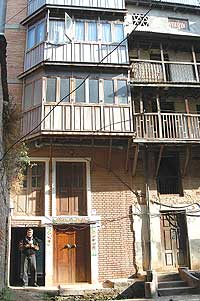 By the 18th century the splendour of Patan rivalled that of any great civilisation. Today, anyone who visits that ancient city square has to visually edit out the rising number of tall cement buildings to imagine what it must have been like when the Malla kings commissioned this remarkable legacy to Nepali architecture. Residents are beginning to realise what they have is irreplaceable and are taking an active interest in preserving and renovating what most people consider the jewel among Kathmandu's seven World Heritage Sites.
By the 18th century the splendour of Patan rivalled that of any great civilisation. Today, anyone who visits that ancient city square has to visually edit out the rising number of tall cement buildings to imagine what it must have been like when the Malla kings commissioned this remarkable legacy to Nepali architecture. Residents are beginning to realise what they have is irreplaceable and are taking an active interest in preserving and renovating what most people consider the jewel among Kathmandu's seven World Heritage Sites. Historically, temples and monuments were safeguarded by the traditional guthi system within the mainly Newari communities that inhabited Patan. Guthis were given land from which the edifices were maintained. But the guthi system soon fell into misuse with guthiyars selling off the land and siphoning money. The monuments they were supposed to safeguard fell into disrepair, with barely enough funds to conduct daily pujas, let alone any renovation work. Still, for the most part, we are not at risk of losing the major temples or the palace itself to neglect or the modernisation drive. There is enough local and international interest to keep these public monuments safe.
Private homes, however, are at greater risk. Kulal Dangol of Jyapu Samaj, an organisation that concentrates on preserving Newari culture, pinpoints the problem succinctly, "Patan residents feel homes must be preserved, but it's hard to support growing families in a small structure, let alone think about restoring it. They need to earn some kind of return from their homes."
Dilendra Raj Shrestha has always lived in Patan and owns the Third World Restaurant just behind Krishna Mandir. Growing up, he saw the Patan of his youth change as new buildings replaced traditional homes. No one had thought of preserving private structures or even renovating them with traditional elements, so Shrestha decided to do something about it.
 Shrestha set up Patan Tourism Development Organisation (PTDO), initially with help from GTZ. Realizing that people must benefit economically from traditional homes if they are to maintain them, Shrestha suggested converting their homes into quality tourist accommodations. A home in Kulimba is nearly finished with UNESCO support and two others are in the pipeline. Shrestha completely restored his own home using traditional materials and reusing all the timber used to build the house in 1936. PTDO funded the restoration with a soft loan scheme with a 3 percent service charge that will be used to promote restored homes. The rest goes back into the revolving fund for restoring more homes. Shrestha's home is now open to all as a source of inspiration.
Shrestha set up Patan Tourism Development Organisation (PTDO), initially with help from GTZ. Realizing that people must benefit economically from traditional homes if they are to maintain them, Shrestha suggested converting their homes into quality tourist accommodations. A home in Kulimba is nearly finished with UNESCO support and two others are in the pipeline. Shrestha completely restored his own home using traditional materials and reusing all the timber used to build the house in 1936. PTDO funded the restoration with a soft loan scheme with a 3 percent service charge that will be used to promote restored homes. The rest goes back into the revolving fund for restoring more homes. Shrestha's home is now open to all as a source of inspiration. An investment of Rs 1.5 million is not within everyone's reach and PTDO has limitations. Shrestha says the government should be more supportive through subsidies like that on timber and show greater leniency on their strict restoration specifications. "A concrete structure with a traditional facade will at least look nice from the outside," he says.
At Kathmandu Valley Preservation Trust (KVPT), Rohit Ranjitjar disagrees: he would rather see homes preserved than reconstructed. KVPT focuses on raising funds to preserve public monuments. Since 1991 they have restored 19 buildings, mostly in Patan, and see a bright future for similar work. For Ranjitkar it's a question of awareness- residents must realise they are part of a collective heritage.
A 115-page document issued by the government through Kathmandu Valley Town Development Committee has building bylaws complete with definitions, diagrams and maps for Kathmandu and Lalitpur. The cities are classified into inner city area and residential zones, both further divided into sub-zones. Guidelines are set for everything from damp proofing building sites to specifications for floor height in a traditional Nepali style structure in each subzone.
With modern buildings replacing traditional homes, we're all edging towards a mass homogeneity. People want hassle-free buildings and easy maintenance. But Ranjitkar points out that the new structures have an average lifespan of eight decades. "Traditional mud mortar timber houses last longer-timber can be replaced, the walls, which are natural insulators, are not difficult to redo and reinforce." It's more expensive, but to Ranjitkar, it is worth every rupee to preserve centuries of Nepal's heritage. While KVPT offers technical solutions to private homeowners, it's difficult to get outside funding for the latter.
Meanwhile, Shrestha dreams of a time when the Patan skyline will once again resemble the glory of old because, "In the future, no one will come to Patan to see just four temples and a darbar. If we are to survive, heritage conservation is crucial."


